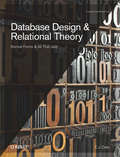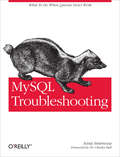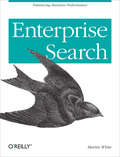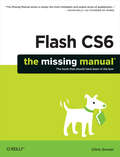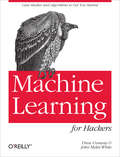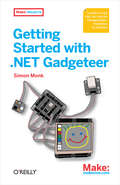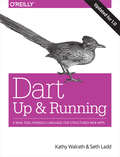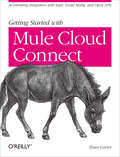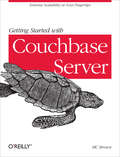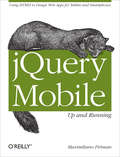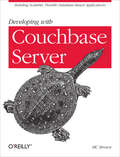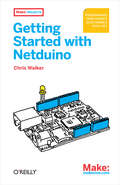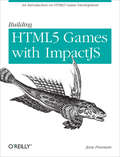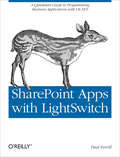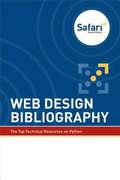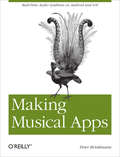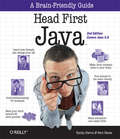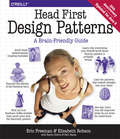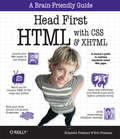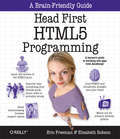- Table View
- List View
Database Design and Relational Theory: Normal Forms and All That Jazz
by C. J. DateWhat makes this book different from others on database design? Many resources on design practice do little to explain the underlying theory, and books on design theory are aimed primarily at theoreticians. In this book, renowned expert Chris Date bridges the gap by introducing design theory in ways practitioners can understand—drawing on lessons learned over four decades of experience to demonstrate why proper database design is so critical in the first place.Every chapter includes a set of exercises that show how to apply the theoretical ideas in practice, provide additional information, or ask you to prove some simple theoretical result. If you’re a database professional familiar with the relational model, and have more than a passing interest in database design, this book is for you.Questions this book answers include:Why is Heath’s Theorem so important?What is The Principle of Orthogonal Design?What makes some JDs reducible and others irreducible?Why does dependency preservation matter?Should data redundancy always be avoided? Can it be?Databases often stay in production for decades, and careful design is critical for avoiding subtle errors and processing problems over time. If they’re badly designed, the negative impacts can be incredibly widespread. This gentle introduction shows you how to use important theoretical results to create good database designs.
MySQL Troubleshooting
by Sveta Smirnova<p>Sometimes applications can go mad: tables contain wrong data, users get random replies, server stop working, and so on. Several easy methods allow users to often find the problems quickly. This book, based on successful conference presentations by the author, cover SQL problems, memory and other server problems, replication, and problems related to particular storage engines.</p>
MySQL Troubleshooting: What To Do When Queries Don't Work
by Sveta SmirnovaStuck with bugs, performance problems, crashes, data corruption, and puzzling output? If you’re a database programmer or DBA, they’re part of your life. The trick is knowing how to quickly recover from them. This unique, example-packed book shows you how to handle an array of vexing problems when working with MySQL.Written by a principal technical support engineer at Oracle, MySQL Troubleshooting provides the background, tools, and expert steps for solving problems from simple to complex—whether data you thought you inserted doesn’t turn up in a query, or the entire database is corrupt because of a server failure. With this book in hand, you’ll work with more confidence.Understand the source of a problem, even when the solution is simpleHandle problems that occur when applications run in multiple threadsDebug and fix problems caused by configuration optionsDiscover how operating system tuning can affect your serverUse troubleshooting techniques specific to replication issuesGet a reference to additional troubleshooting techniques and tools, including third-party solutionsLearn best practices for safe and effective troubleshooting—and for preventing problems
Enterprise Search: Enhancing Business Performance
by Martin WhiteIs your organization rapidly accumulating more information than you know how to manage? This book helps you create an enterprise search solution based on more than just technology. Author Martin White shows you how to plan and implement a managed search environment that meets the needs of your business and your employees. Learn why it’s vital to have a dedicated staff manage your search technology and support your users.In one survey, 93% of executives said their organization is losing revenue because they’re not fully able to use the information they collect. With this book, business managers, IT managers, and information professionals can maximize the value of corporate information and data assets.Use 12 critical factors to gauge your organization’s search needsLearn how to make a business case for searchResearch your user requirements and evaluate your current search solutionCreate a support team with technical skills and organizational knowledge to manage your solutionSet quality guidelines for organizational content and metadataGet an overview of open source and commercial search technologyChoose an application based on your requirements, not for its featuresMake mobile and location-independent search part of your solution
Flash CS6: The Missing Manual
by Chris Grover<p>You can build everything from simple animations to full-fledged iPhone, iPad, and Android apps with Flash CS6, but learning this complex program can be difficult—unless you have this fully updated, bestselling guide. Learn how to create gorgeous Flash effects even if you have no programming experience. With <i>Flash CS6: The Missing Manual</i>, you’ll move from the basics to power-user tools with ease.</p>
Machine Learning for Hackers: Case Studies and Algorithms to Get You Started
by John Myles White Drew ConwayIf you’re an experienced programmer interested in crunching data, this book will get you started with machine learning—a toolkit of algorithms that enables computers to train themselves to automate useful tasks. Authors Drew Conway and John Myles White help you understand machine learning and statistics tools through a series of hands-on case studies, instead of a traditional math-heavy presentation.Each chapter focuses on a specific problem in machine learning, such as classification, prediction, optimization, and recommendation. Using the R programming language, you’ll learn how to analyze sample datasets and write simple machine learning algorithms. Machine Learning for Hackers is ideal for programmers from any background, including business, government, and academic research.Develop a naïve Bayesian classifier to determine if an email is spam, based only on its textUse linear regression to predict the number of page views for the top 1,000 websitesLearn optimization techniques by attempting to break a simple letter cipherCompare and contrast U.S. Senators statistically, based on their voting recordsBuild a “whom to follow” recommendation system from Twitter data
Monitoring with Ganglia: Tracking Dynamic Host and Application Metrics at Scale
by Robert Alexander Matt Massie Bernard Li Brad Nicholes Vladimir Vuksan Jeff Buchbinder Frederiko Costa Alex Dean Dave Josephsen Peter Phaal Daniel PocockWritten by Ganglia designers and maintainers, this book shows you how to collect and visualize metrics from clusters, grids, and cloud infrastructures at any scale. Want to track CPU utilization from 50,000 hosts every ten seconds? Ganglia is just the tool you need, once you know how its main components work together. This hands-on book helps experienced system administrators take advantage of Ganglia 3.x.Learn how to extend the base set of metrics you collect, fetch current values, see aggregate views of metrics, and observe time-series trends in your data. You’ll also examine real-world case studies of Ganglia installs that feature challenging monitoring requirements.Determine whether Ganglia is a good fit for your environmentLearn how Ganglia’s gmond and gmetad daemons build a metric collection overlayPlan for scalability early in your Ganglia deployment, with valuable tips and adviceTake data visualization to a new level with gweb, Ganglia’s web frontendWrite plugins to extend gmond’s metric-collection capabilityTroubleshoot issues you may encounter with a Ganglia installationIntegrate Ganglia with the sFlow and Nagios monitoring systemsContributors include: Robert Alexander, Jeff Buchbinder, Frederiko Costa, Alex Dean, Dave Josephsen, Peter Phaal, and Daniel Pocock. Case study writers include: John Allspaw, Ramon Bastiaans, Adam Compton, Andrew Dibble, and Jonah Horowitz.
Getting Started with .NET Gadgeteer: Learn to Use This .NET Micro Framework-Powered Platform
by Simon MonkLearn how to quickly build cool electronic gadgets with .NET Gadgeteer. With the easy-to-follow instructions in this guide, you’ll tackle five fascinating projects, using Microsoft’s rapid prototyping Gadgeteer platform. There’s no soldering involved—you simply plug in modules that make gadget-building quick and easy.Ideal for beginners, this book shows you how to work with modules and other hardware in the popular Fez Spider Starter Kit, and teaches you how to program your gadgets with Visual Studio C# Express and the .NET Micro Framework 4.1 SDK. You’ll soon learn a wide range of programming techniques along with the skills to design your own projects.Get to know the software and hardware with a simple LED projectDownload code from the companion site to build and test each projectBuild a spy camera that automatically captures and saves images at regular intervalsConstruct a simple animated game with the joystick moduleCreate a web server that sends messages you draw or write on the touchscreen moduleBuild a gadget that backs up digital images from an SD card to a USB flash driveLearn about other .NET Gadgeteer modules for creating environmental sensors, an MP3 player, and a WiFi network
Dart: A New, Tool-Friendly Language for Structured Web Apps
by Kathy Walrath Seth LaddGet moving with Dart, the development platform that helps you build high-performance HTML5 apps for the modern Web. With this guide, you’ll take a hands-on tour of the Dart language, libraries, and tools—including its editor and virtual machine—for developing structured, fast, and maintainable web apps that run on both the client and the server.Written by developer advocates at Google, this updated edition covers Dart 1.0. Google designed Dart to boost performance and help developers work more efficiently. This book shows you how to build everything from simple scripts to complex apps that work well in today’s browsers.Build web apps with the object-oriented Dart language, and compile your code to JavaScriptDelve into language features, from optional types and method cascades to named constructorsCreate, launch, and debug web and command-line apps with Dart EditorExplore Dart APIs, including dart:core, dart:html, dart:io, dart:convert, and dart:mirrorsUse tools such as Dartium, the Chromium-based browser that can run Dart apps nativelyWalk through Dartiverse Search, a client-server app that combines useful and fun language and API features
Getting Started with Mule Cloud Connect: Accelerating Integration with SaaS, Social Media, and Open APIs
by Ryan CarterConnect your enterprise to a wide range of SaaS platforms, Open APIs, and social networks quickly and without difficulty. Through step-by-step instructions and numerous real-world examples, this concise guide shows you how to seamlessly integrate the external services you need with Mule ESB and its powerful Cloud Connect toolset.You’ll learn how to use service-specific connectors for many popular APIs—including Salesforce, Twitter, LinkedIn, and Twilio—through easy-to-learn abstractions. If Mule doesn’t have a connector for the resource you need, you’ll learn how to build your own. You’ll discover how easy it is to reach beyond the enterprise firewall for a host of Internet resources.Discover the advantages of using Mule Cloud Connect over typical web service clients and protocolsLearn how Cloud Connectors eliminate the need to understand the underlying API of each serviceGet started with the latest real-time technologies, including REST, WebHooks, and Streaming APIsIntegrate OAuth secure APIs and understand their role in authorization and information sharingDelve into advanced topics such as multi-tenancy and connection managementBuild your own custom connectors with the Mule DevKit
Getting Started with Couchbase Server: Extreme Scalability at Your Fingertips
by Mc BrownDo you know what to do if your web application goes viral and usage suddenly explodes? This concise guide introduces you to Couchbase Server, an extremely fast NoSQL database that automatically distributes data across a cluster of commodity servers or virtual machines. You’ll learn hands-on how to build a Couchbase cluster without changing your application, and how to expand your database on the fly without interrupting service.Discover how this open source server can help your application gain scalability and performance.Learn how the server’s architecture affects the way you build and deploy your databaseStore data without defining a data structure—and retrieve it without complex queries or query languagesUse a formula to estimate your cluster size requirementsSet up individual nodes through a browser, command line, or REST APIEnable your application to read and write data with sub-millisecond latency through managed object cachingGet a quick guide to building applications that integrate Couchbase’s core protocolIdentify problems in your cluster with the web consoleExpand or shrink your cluster, handle failovers, and back up data
jQuery Mobile: Up and Running
by Maximiliano Firtman<p>Would you like to build one mobile web application that works on iPad and Kindle Fire as well as iPhone and Android smartphones? This introductory guide to jQuery Mobile shows you how. Through a series of hands-on exercises, you’ll learn the best ways to use this framework’s many interface components to build customizable, multiplatform apps. You don’t need any programming skills or previous experience with jQuery to get started.</p>
jQuery Mobile: Up and Running
by Maximiliano FirtmanWould you like to build one mobile web application that works on iPad and Kindle Fire as well as iPhone and Android smartphones? This introductory guide to jQuery Mobile shows you how. Through a series of hands-on exercises, you’ll learn the best ways to use this framework’s many interface components to build customizable, multiplatform apps. You don’t need any programming skills or previous experience with jQuery to get started.By the time you finish this book, you’ll know how to create responsive, Ajax-based interfaces that work on a variety of smartphones and tablets, using jQuery Mobile and semantic HTML5 code.Understand how jQuery Mobile works with HTML5, CSS3, and JavaScriptWork with UI components to format content and create forms, lists, navbars, and buttonsCreate dynamic content with JavaScript, Ajax, and the jQuery core frameworkCustomize your entire user interface with themes and CSS3Enable users to install your app from the browser and work with it offlineDistribute through app stores by packaging your creation as a native app
Developing with Couchbase Server: Building Scalable, Flexible Database-Based Applications
by Mc BrownToday’s highly interactive websites pose a challenge for traditional SQL databases—the ability to scale rapidly and serve loads of concurrent users. With this concise guide, you’ll learn how to build web applications on top of Couchbase Server 2.0, a NoSQL database that can handle websites and social media where hundreds of thousands of users read and write large volumes of information.Using food recipe information as examples, this book demonstrates how to take advantage of Couchbase’s document-oriented database design, and how to store and query data with various CRUD operations. Discover why Couchbase is better than SQL databases with memcached tiers for managing data from the most interactive portions of your application.Learn about Couchbase Server’s cluster-based architecture and how it differs from SQL databasesChoose a client library for Java, .NET, Ruby, Python, PHP, or C, and connect to a clusterStructure data in a variety of formats, from serialized objects, a stream of raw bytes, or as JSON documentsLearn core storage and retrieval methods, including document IDs, expiry times, and concurrent updatesCreate views with map/reduce and learn Couchbase mechanisms for querying and selection
Getting Started with Netduino: Open Source Electronics Projects with .NET
by Chris WalkerStart building electronics projects with Netduino, the popular open source hardware platform that’s captured the imagination of makers and hobbyists worldwide. This easy-to-follow book provides the step-by-step guidance you need to experiment with Netduino and the .NET Micro Framework.Through a set of simple projects, you’ll learn how to create electronic gadgets—including networked devices that communicate over TCP/IP. Along the way, hobbyists will pick up the basics of .NET programming, and programmers will discover how to work with electronics and microcontrollers. Follow the projects in sequence and learn techniques for building your own Netduino-based devices.Get an overview of the Netduino microcontroller familyInstall the free Visual Studio Express, .NET Micro Framework, and Netduino SDKWrite code that lets you turn Netduino’s LED on and offLearn how to increase Netduino’s capabilities with various expansion shieldsMeasure digital and analog inputs with MakerShieldMake a light appear dimmer or brighter with Pulse Width ModulationUse electrical pulses to play a song and control the position of a servo motorCreate an app to control your Netduino over the Web
Building HTML5 Games with ImpactJS: An Introduction On HTML5 Game Development
by Jesse FreemanCreate a real 2D game from start to finish with ImpactJS, the JavaScript game framework that works with the HTML5's Canvas element. Making video games is hard work that requires technical skills, a lot of planning, and—most critically—a commitment to completing the project. With this hands-on guide, you’ll learn how to use Impact with other technologies step-by-step.You’ll pick up important tips about game design, and discover how to publish Impact games to the Web, desktop, and mobile—including a method to package your game as a native iOS app. Packed with screen shots and sample code, this book is ideal for game developers of all levels.Set up your development environment and discover Impact’s advantagesBuild a complete game with core logic, collision detection, and player and monster behaviorLearn why a game design document is critical before you start buildingDisplay and animate game artwork with sprite sheetsAdd sound effects, background music, and textCreate screens to display stats and in-game statusPrepare to publish by baking your game files into a single file
SharePoint Apps with LightSwitch: A Quickstart Guide to Programming Business Applications in VB.NET
by Paul FerrillBuild custom business applications for SharePoint with Visual Studio LightSwitch—including intuitive apps that don’t require a single line of code. This example-driven guide takes non-programmers step-by-step through the process of creating simple apps and utilities, and shows programmers familiar with C# or Visual Basic how to build customized applications with more functionality.Discover how to build and test your applications quickly without a lot of expensive server hardware. Once you get up to speed with LightSwitch, you’ll create quality line-of-business applications tailored to specific customer needs in no time, whether you work in-house or for a vendor.Learn how the LightSwitch Presentation, Logic, and Storage layers work behind the scenesConfigure your SharePoint server and workstation to work with this development environmentNavigate the graphical environment and its various user screensUse examples to build simple single-function applications for search and data entryExpand your app’s capabilities by using LightSwitch extensions and Silverlight controlsConnect your LightSwitch app to external data sources, such as Excel, SQL Server, SQLite, and cloud-based applications
Web Design Bibliography
by Safari Books Online Content TeamEvery day more people adopt the Web and more uses for this technology are discovered. This has created an overwhelming demand for designers, specifically ones who can craft beautiful, usable and emotionally engaging websites. Becoming a great web designer is no easy task, since it requires dozens of skills beyond graphical comprehension. If you want resources to help you acquire these skills or hone existing ones, then this guide can help. Tap into books and videos that cover everything from design principles to usability to user interfaces and typography to layout to color, and more.
Web Development Bibliography
by Safari Books Online Content TeamToday's web applications are powerful and interactive that have to work equally well on a variety of web browsers on desktop computers, tablets, and smartphones. Many of the most popular web applications are able to do all of this while scaling to handle thousands of requests per second from all over the globe. It's a good thing that the list of technologies and tools for creating these web applications has also grown rapidly to enable web developers to build them. This guide allows you to tap into books and videos that cover the major technologies required to build Web apps: from JavaScript and HTML5 and CSS3 to Java and PHP to jQuery, Node.js and more.
Making Musical Apps
by Peter BrinkmannWant to turn your mobile device into a musical instrument? Or equip your game with interactive audio, rather than canned samples? You can do it with Pure Data (Pd), an open source visual programming environment that lets you manipulate digital audio in real time. This concise book shows you how to use Pd--with help from the libpd library--as an easily embeddable and widely portable sound engine. Whether you're an audio developer looking to create musical apps with sophisticated audio capabilities, or an application developer ready to enhance mobile games with real-time procedural audio, Making Musical Apps introduces you to Pd and libpd, and provides hands-on instructions for creating musical apps for Android and iOS. Get a crash course in Pd, and discover how to generate and control sounds Learn how to create and deploy algorithmic compositions that react to a user's activity and environment Use Java or Objective-C to integrate Pd and libpd into mobile apps Learn the steps necessary to build libpd-based apps for Android and iOS
Making Musical Apps: Real-time audio synthesis on Android and iOS
by Peter BrinkmannWant to turn your mobile device into a musical instrument? Or equip your game with interactive audio, rather than canned samples? You can do it with Pure Data (Pd), an open source visual programming environment that lets you manipulate digital audio in real time. This concise book shows you how to use Pd—with help from the libpd library—as an easily embeddable and widely portable sound engine.Whether you’re an audio developer looking to create musical apps with sophisticated audio capabilities, or an application developer ready to enhance mobile games with real-time procedural audio, Making Musical Apps introduces you to Pd and libpd, and provides hands-on instructions for creating musical apps for Android and iOS.Get a crash course in Pd, and discover how to generate and control soundsLearn how to create and deploy algorithmic compositions that react to a user’s activity and environmentUse Java or Objective-C to integrate Pd and libpd into mobile appsLearn the steps necessary to build libpd-based apps for Android and iOS
Head First Java: A Brain-Friendly Guide (Head First)
by Bert Bates Kathy SierraLearning a complex new language is no easy task especially when it s an object-oriented computer programming language like Java. You might think the problem is your brain. It seems to have a mind of its own, a mind that doesn't always want to take in the dry, technical stuff you're forced to study. The fact is your brain craves novelty. It's constantly searching, scanning, waiting for something unusual to happen. After all, that's the way it was built to help you stay alive. It takes all the routine, ordinary, dull stuff and filters it to the background so it won't interfere with your brain's real work--recording things that matter. How does your brain know what matters? It's like the creators of the Head First approach say, suppose you're out for a hike and a tiger jumps in front of you, what happens in your brain? Neurons fire. Emotions crank up. Chemicals surge. That's how your brain knows. And that's how your brain will learn Java. Head First Java combines puzzles, strong visuals, mysteries, and soul-searching interviews with famous Java objects to engage you in many different ways. It's fast, it's fun, and it's effective. And, despite its playful appearance, Head First Java is serious stuff: a complete introduction to object-oriented programming and Java. You'll learn everything from the fundamentals to advanced topics, including threads, network sockets, and distributed programming with RMI. And the new. second edition focuses on Java 5.0, the latest version of the Java language and development platform. Because Java 5.0 is a major update to the platform, with deep, code-level changes, even more careful study and implementation is required. So learning the Head First way is more important than ever. If you've read a Head First book, you know what to expect--a visually rich format designed for the way your brain works. If you haven't, you're in for a treat. You'll see why people say it's unlike any other Java book you've ever read. By exploiting how your brain works, Head First Java compresses the time it takes to learn and retain--complex information. Its unique approach not only shows you what you need to know about Java syntax, it teaches you to think like a Java programmer. If you want to be bored, buy some other book. But if you want to understand Java, this book's for you.
Head First Design Patterns
by Bert Bates Kathy Sierra Eric Freeman Elisabeth RobsonYou're not alone. At any given moment, somewhere in the world someone struggles with the same software design problems you have. You know you don't want to reinvent the wheel (or worse, a flat tire), so you look to Design Patterns--the lessons learned by those who've faced the same problems. With Design Patterns, you get to take advantage of the best practices and experience of others, so that you can spend your time on...something else. Something more challenging. Something more complex. Something more fun. You want to learn about the patterns that matter--why to use them, when to use them, how to use them (and when NOT to use them). But you don't just want to see how patterns look in a book, you want to know how they look "in the wild". In their native environment. In other words, in real world applications. You also want to learn how patterns are used in the Java API, and how to exploit Java's built-in pattern support in your own code. You want to learn the real OO design principles and why everything your boss told you about inheritance might be wrong (and what to do instead). You want to learn how those principles will help the next time you're up a creek without a design pattern. Most importantly, you want to learn the "secret language" of Design Patterns so that you can hold your own with your co-worker (and impress cocktail party guests) when he casually mentions his stunningly clever use of Command, Facade, Proxy, and Factory in between sips of a martini. You'll easily counter with your deep understanding of why Singleton isn't as simple as it sounds, how the Factory is so often misunderstood, or on the real relationship between Decorator, Facade and Adapter. With Head First Design Patterns, you'll avoid the embarrassment of thinking Decorator is something from the "Trading Spaces" show. Best of all, in a way that won't put you to sleep! We think your time is too important (and too short) to spend it struggling with academic texts. If you've read a Head First book, you know what to expect--a visually rich format designed for the way your brain works. Using the latest research in neurobiology, cognitive science, and learning theory, Head First Design Patterns will load patterns into your brain in a way that sticks. In a way that lets you put them to work immediately. In a way that makes you better at solving software design problems, and better at speaking the language of patterns with others on your team.
Head First HTML with CSS & XHTML
by Eric Freeman Elisabeth RobsonTired of reading HTML books that only make sense after you're an expert? Then it's about time you picked up Head First HTML with CSS & XHTML and really learned HTML. You want to learn HTML so you can finally create those web pages you've always wanted, so you can communicate more effectively with friends, family, fans, and fanatic customers. You also want to do it right so you can actually maintain and expand your Web pages over time, and so your web pages work in all the browsers and mobile devices out there. Oh, and if you've never heard of CSS, that's okay - we won't tell anyone you're still partying like it's 1999 - but if you're going to create Web pages in the 21st century then you'll want to know and understand CSS. Learn the real secrets of creating Web pages, and why everything your boss told you about HTML tables is probably wrong (and what to do instead). Most importantly, hold your own with your co-worker (and impress cocktail party guests) when he casually mentions how his HTML is now strict, and his CSS is in an external style sheet. With Head First HTML with CSS & XHTML, you'll avoid the embarrassment of thinking web-safe colors still matter, and the foolishness of slipping a font tag into your pages. Best of all, you'll learn HTML and CSS in a way that won't put you to sleep. If you've read a Head First book, you know what to expect: a visually-rich format designed for the way your brain works. Using the latest research in neurobiology, cognitive science, and learning theory, this book will load HTML, CSS, and XHTML into your brain in a way that sticks. So what are you waiting for? Leave those other dusty books behind and come join us in Webville. Your tour is about to begin. "Elegant design is at the core of every chapter here, each concept conveyed with equal doses of pragmatism and wit." --Ken Goldstein, Executive Vice President, Disney Online "This book is a thoroughly modern introduction to forward-looking practices in web page markup and presentation." --Danny Goodman, author of Dynamic HTML: The Definitive Guide "What used to be a long trial and error learning process has now been reduced neatly into an engaging paperback." --Mike Davidson, CEO, Newsvine, Inc. "I love Head First HTML with CSS & XHTML--it teaches you everything you need to learn in a 'fun coated' format!" --Sally Applin, UI Designer and Artist "I haven't had as much fun reading a book (other than Harry Potter) in years. And your book finally helped me break out of my hapless so-last-century way of creating web pages." --Professor David M. Arnow, Department of Computer and Information Science, Brooklyn College "If you've ever had a family member who wanted you to design a website for them, buy them Head First HTML with CSS and XHTML. If you've ever asked a family member to design you a web site, buy this book. If you've ever bought an HTML book and ended up using it to level your desk, or for kindling on a cold winter day, buy this book. This is the book you've been waiting for. This is the learning system you've been waiting for." --Warren Kelly, Blogcritics.org
Head First HTML5 Programming: Building Web Apps with JavaScript
by Eric Freeman Elisabeth RobsonHTML has been on a wild ride. Sure, HTML started as a mere markup language, but more recently HTML’s put on some major muscle. Now we’ve got a language tuned for building web applications with Web storage, 2D drawing, offline support, sockets and threads, and more. And to speak this language you’ve got to go beyond HTML5 markup and into the world of the DOM, events, and JavaScript APIs.Now you probably already know all about HTML markup (otherwise known as structure) and you know all aboutCSS style (presentation), but what you’ve been missing is JavaScript (behavior). If all you know about are structure and presentation, you can create some great looking pages, but they’re still just pages. When you add behavior with JavaScript, you can create an interactive experience; even better, you can create full blown web applications.Head First HTML5 Programming is your ultimate tour guide to creating web applications with HTML5 and JavaScript, and we give you everything you need to know to build them, including: how to add interactivity to your pages, how to communicate with the world of Web services, and how to use the great new APIs being developed for HTML5.Here are just some of the things you’ll learn in Head First HTML5 Programing:Learn how to make your pages truly interactive by using the power of the DOM.Finally understand how JavaScript works and take yourself from novice to well-informed in just a few chapters.Learn how JavaScript APIs fit into the HTML5 ecosystem, and how to use any API in your web pages.Use the Geolocation API to know where your users are.Bring out your inner artist with Canvas, HTML5’s new 2D drawing surface.Go beyond just plugging a video into your pages, and create custom video experiences.Learn the secret to grabbing five megabytes of storage in every user’s browser.Improve your page’s responsiveness and performance with Web workers.And much more.
